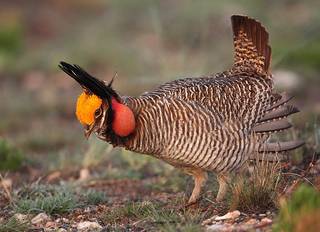
Agricultural News
Cattle Industry Waits on Possible Endangered Species Ruling on Lesser Prairie Chicken
Wed, 31 Jul 2019 12:51:32 CDT
 In 2014, the US government listed the Lesser Prairie Chicken as a Threatened Species under the Endangered Species Act, one step closer to being classified as an Endangered Species. In an effort to keep that from happening, the US Fish & Wildlife Service collaborated with stakeholders and private landowners including ranchers, to develop a range-wide plan to reestablish habitat for the bird. Despite the fact that the species' population has nearly doubled since those efforts were undertaken, the agency is again considering the possibility of listing the bird, due to a failure to reach the necessary habitat goals outlined in the aforementioned plan. Ethan Lane, executive director of the Public Lands Council for the National Cattlemen's Beef Association, is now working with USFW and industry stakeholders to keep the Lesser Prairie Chicken off the Endangered Species List. During NCBA's Summer Business Meeting in Denver this week, Lane sat down with Radio Oklahoma Ag Network Farm Director Ron Hays to explain what measures he is taking to accomplish that and what it would mean for producers if the species is ever listed. You can listen to their complete conversation by clicking or tapping the LISTEN BAR below at the bottom of the page.
In 2014, the US government listed the Lesser Prairie Chicken as a Threatened Species under the Endangered Species Act, one step closer to being classified as an Endangered Species. In an effort to keep that from happening, the US Fish & Wildlife Service collaborated with stakeholders and private landowners including ranchers, to develop a range-wide plan to reestablish habitat for the bird. Despite the fact that the species' population has nearly doubled since those efforts were undertaken, the agency is again considering the possibility of listing the bird, due to a failure to reach the necessary habitat goals outlined in the aforementioned plan. Ethan Lane, executive director of the Public Lands Council for the National Cattlemen's Beef Association, is now working with USFW and industry stakeholders to keep the Lesser Prairie Chicken off the Endangered Species List. During NCBA's Summer Business Meeting in Denver this week, Lane sat down with Radio Oklahoma Ag Network Farm Director Ron Hays to explain what measures he is taking to accomplish that and what it would mean for producers if the species is ever listed. You can listen to their complete conversation by clicking or tapping the LISTEN BAR below at the bottom of the page.
"The Lesser Prairie Chicken is a frustrating bird. Back in 2014, they found the species to be threatened, which at the time there were about 16,000 to 17,000 birds on the ground. We're at 38,000 and climbing right now," Lane said. "But as is the case with these kind of species - Fish & Wildlife focuses on habitat rather than the numbers. So, it's sort of a moving target. They're looking at that long-term sustainability based on habitat."
This is where those range-wide plans come into play, Lane says, where industry stakeholders that have an impact on the environment and surrounding habitat can leverage the good work done by ranchers on the ground. As part of the plan that has been in place, ranchers' role was to essentially build and create habitat for the bird with help from the oil and gas and wind energy industries. Based on the population growth, Lane argues that the evidence these efforts have been successful are clear.
"I continue to say ranchers have shown up and done their jobs. We've created that habitat. We know it's there, we know the birds are there and we're seeing that in the population," he said. "But, being what it is, we're going to find ourselves back in a situation where Fish & Wildlife is going to be forced into doing what they have to do in order to defend it in court from these radical environmentalists who always come in and sue. Based on that, they have a very difficult path ahead of them."
Given the situation, it has been decided that the best course of action to avoid or at least minimize any potential impacts on ranchers, is to focus on the regulatory side of this issue and work toward reforming the current regulations under the ESA. Oklahoma's Senior Senator Jim Inhofe has even stepped in with his own suggestions of changes that could be made to alleviate the regulatory burden on landowners that comes with an ESA listing.
"We're talking about 95% of a species that exists on private ground. So, it can impact how you run your operation. Anything that requires a permit or evaluation- any NRCS programs- you have to factor in now that you have an Endangered Species on your property," Lane explained. "It's a tremendous burden on our producers and often what we find is it is inhibiting them from doing good conservation work. The bureaucracy is actually a hindrance that keeps them from doing what they know is best for the landscape. That's why we're focusing on that regulatory side to help make that less of a burden for producers."
WebReadyTM Powered by WireReady® NSI
Top Agricultural News
More Headlines...





